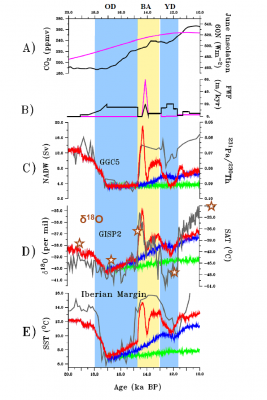Younger Dryas Cooling and the Greenland Climate Response to CO2
Greenland ice-core δ18O-temperature reconstructions suggest a dramatic cooling during the Younger Dryas (YD; 12-9-11.7 ka), with temperatures being as cold as the earlier Oldest Dryas (OD; 18.0-14.6 ka) despite an ~50 ppm rise in atmospheric CO2. Such YD cooling implies a muted Greenland climate response to atmospheric CO2, contrary to physical predictions of an enhanced high-latitude response to future increases in CO2. Here we show that North Atlantic sea surface temperature (SST) reconstructions as well as transient climate model simulations suggest that the YD over Greenland should be substantially warmer than the OD by ~5oC in response to increased atmospheric CO2. Additional experiments with an isotope-enabled model suggest that the apparent YD temperature reconstruction derived from the ice-core δ18O record is likely an artifact of an altered temperature-δ18O relationship due to changing deglacial atmospheric circulation.
Our results thus suggest that Greenland climate was warmer during the YD relative to the OD in response to rising atmospheric CO2, consistent with SST reconstructions and physical predictions, and has a sensitivity approximately twice that found in climate models for current climate due to an enhanced albedo feedback during the last deglaciation. This study provides a powerful example how climate models and isotope models can be combined with past climate records to improve our understanding of climate changes.

